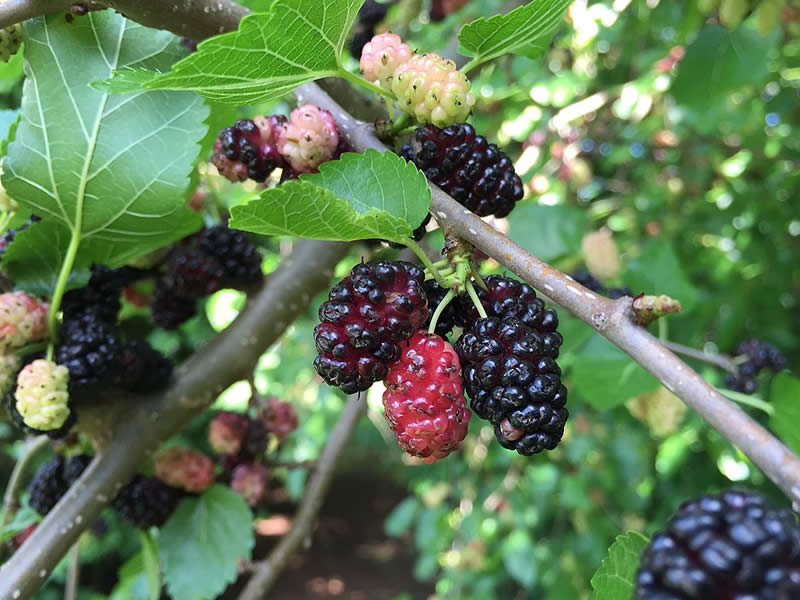Mulberry, Red
Sweet Berries & Wildlife-Friendly Tree
Mulberry, Red - 1 Gallon / 2-3ft is backordered and will ship as soon as it is back in stock.
Couldn't load pickup availability
Delivery and Shipping
Delivery and Shipping
Nonperishable items ship within 48 business hours. Perishable items ship seasonally during mild weather, i.e. winter preorders ship in spring, summer preorders ship in fall.
Red Mulberry is a resilient, native fruit tree known for its sweet, juicy berries and its adaptability to diverse growing conditions. This small-to-medium-sized deciduous tree produces an abundance of dark purple-red berries that ripen in late spring to early summer, providing a tasty treat for people, birds, and other wildlife. With broad, heart-shaped leaves and a spreading canopy, Red Mulberry is well-suited for naturalized areas, wildlife gardens, and edible landscapes. This hardy tree's fast growth, abundant fruit production, and wildlife value make it a valuable addition to any ecologically focused planting.
Key Characteristics
-
Abundant, Edible Berries: Red Mulberry's berries are sweet, juicy, and high in antioxidants, ideal for fresh eating, making jams, or drying. The berries ripen in late spring to early summer, providing a bountiful harvest of flavorful fruit that's a favorite of gardeners and wildlife alike.
-
Wildlife Magnet: The berries of Red Mulberry attract a wide range of wildlife, including birds like cedar waxwings, bluebirds, and thrushes, as well as small mammals. Its dense canopy and broad leaves provide nesting sites and shelter for birds and pollinators, enhancing biodiversity in the landscape.
-
Adaptable and Fast-Growing: Red Mulberry is tolerant of a variety of soils, including moist, well-drained, and even rocky soils, and can thrive in both full sun and partial shade. Its rapid growth rate makes it a good choice for quickly establishing shade or food production in permaculture systems or food forests.
-
Low Maintenance and Hardy: Once established, Red Mulberry requires minimal care, is resistant to most pests and diseases, and can tolerate some drought. Its hardiness makes it suitable for low-maintenance landscapes and larger naturalized areas.
-
Medicinal and Cultural Uses: Historically, the leaves, bark, and berries of Red Mulberry have been used in traditional remedies. The berries are rich in vitamins C and K, adding nutritional value and heritage significance to this native tree.
Product Details
- Native Range: Eastern and Central North America
- Plant Life Cycle: Deciduous tree
- Sun Requirements: Full sun to part shade
- Soil Requirements: Prefers moist, well-drained soils; tolerates rocky and slightly acidic soils
- Mature Height: 35-50 feet
- Bloom Time: Spring (inconspicuous flowers)
- Fruit Color: Dark purple-red
- Fruit Ripening Season: Late spring to early summer
- USDA Hardiness Zones: 4-9
Red Mulberry's delicious fruit, wildlife value, and ease of care make it an excellent choice for food forests, edible landscapes, and wildlife gardens where it contributes to ecological health and seasonal beauty.
-
Sun RequirementsFull Sun, Part Sun/Shade
-
Soil RequirementsMedium, Medium-Wet
-
Bloom ColorGreen, Yellow
-
Bloom TimeApril, May
-
USDA Hardiness ZonesZone 4, Zone 5, Zone 6, Zone 7, Zone 8
-
Native StatesMaine, Vermont, New Hampshire, New York, Pennsylvania, Ohio, Indiana, Illinois, Michigan, Wisconsin, Missouri, Kentucky, Tennessee, Virginia, North Carolina, South Carolina, Georgia, Alabama, Mississippi, Arkansas, Louisiana, Texas
Payment & Security
Payment methods
Your payment information is processed securely. We do not store credit card details nor have access to your credit card information.




